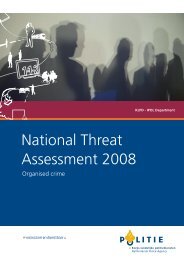Assessing the Effectiveness of Organized Crime Control Strategies ...
Assessing the Effectiveness of Organized Crime Control Strategies ...
Assessing the Effectiveness of Organized Crime Control Strategies ...
You also want an ePaper? Increase the reach of your titles
YUMPU automatically turns print PDFs into web optimized ePapers that Google loves.
In <strong>the</strong> first two and one-half years, <strong>the</strong> task forces produced 1,721 indictments against 6,545<br />
defendants, <strong>the</strong> majority through plea agreements (President’s Commission on <strong>Organized</strong> <strong>Crime</strong>,<br />
1986:319; General Accounting Office, 1987:13). The conviction rate is about 95 percent in<br />
cases reaching disposition and assets seized approach <strong>the</strong> cost <strong>of</strong> <strong>the</strong> program. In its first two<br />
years, assets seized totaled US$158 million and forfeitures totaled US$52 million (General<br />
Accounting Office, 1987:9). In addition, close to US$10 million in fines were assessed during<br />
<strong>the</strong> first two years <strong>of</strong> <strong>the</strong> program. The task forces have also enhanced international cooperation<br />
among law enforcement agencies as nearly half <strong>the</strong> cases target organizations that are<br />
international in scope.<br />
In Canada, <strong>the</strong> <strong>Organized</strong> <strong>Crime</strong> Agency <strong>of</strong> British Columbia (2001/2002) operates like <strong>the</strong><br />
American task forces. Established in 1999, it has developed close working relationships with<br />
many Canadian law enforcement agencies, as well as <strong>the</strong> Canada Customs and Revenue Agency,<br />
<strong>the</strong> FBI, and <strong>the</strong> US Drug Enforcement Agency, among o<strong>the</strong>rs. On average, projects include<br />
eight to nine partners. While no independent assessment as to <strong>the</strong> outcome <strong>of</strong> OCABC<br />
operations have been conducted, its 2001/2002 Annual Report claims that it has caused<br />
“disruption and suppression <strong>of</strong> organized crime group activities such as geographic<br />
displacement, friction and mistrust among crime groups and disruption <strong>of</strong> drug distribution<br />
networks” (OCABC, 2001/2002:14). In addition, one case led to <strong>the</strong> confiscation <strong>of</strong> $6 million<br />
in assets.<br />
4.13 Undercover Operations and Informants<br />
Undercover work may involve one or more <strong>of</strong>: informants, who are usually suspects who have<br />
“flipped” and are exchanging information for consideration in terms <strong>of</strong> charges or at sentencing;<br />
paid agents, who are insiders receiving cash for information; or, undercover <strong>of</strong>ficers, who are<br />
police <strong>of</strong>ficers trying to infiltrate criminal organizations or obtain information about <strong>the</strong>ir<br />
operations (Beare, 1996:189).<br />
Proceeds <strong>of</strong> crime and money laundering investigations, for example, <strong>of</strong>ten require sophisticated<br />
undercover work involving <strong>the</strong> establishment <strong>of</strong> elaborate storefront money laundering<br />
operations. These storefronts are staffed by individuals knowledgeable about financial<br />
transactions and laundering. The goal <strong>of</strong> such operations is to gain <strong>the</strong> confidence <strong>of</strong> <strong>the</strong><br />
criminal organization toward <strong>the</strong> end <strong>of</strong> learning more about its personnel and operations. Sting<br />
operations <strong>of</strong> this type sometimes produce many convictions, but may be costly, involving many<br />
<strong>of</strong>ficers over a considerable period <strong>of</strong> time (Albanese, 1996:181).<br />
Undercover work is dangerous—<strong>the</strong> danger appears to increase in proportion to <strong>the</strong> severity <strong>of</strong><br />
sentences targets <strong>of</strong> such operations stand to serve—and open to manipulation (Beare, 1996:190-<br />
191). For example, informers might provide false information in order to receive payments or to<br />
punish competitors or enemies (Marx, 1988:152). O<strong>the</strong>r informers may become overzealous<br />
“supercops” and create criminals, using prohibited methods. Because <strong>of</strong> <strong>the</strong>ir protected status,<br />
<strong>the</strong> information <strong>the</strong>y provide and techniques <strong>the</strong>y use to ga<strong>the</strong>r information are rarely challenged.<br />
Marx (1988:153) points out that informers are <strong>of</strong>ten unchallenged because <strong>the</strong>y rarely appear in<br />
court. These court appearances are rare because “<strong>the</strong> information <strong>the</strong>y provide is used to obtain a<br />
warrant or <strong>the</strong>y are “cut away” after providing an introduction for a sworn agent.”<br />
Research and Statistics Division / Department <strong>of</strong> Justice Canada | 43








